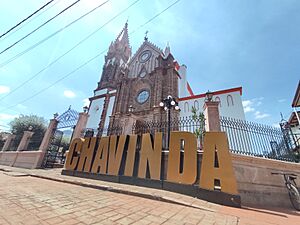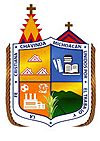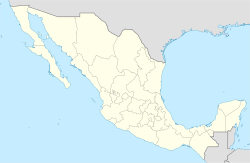Chavinda facts for kids
Quick facts for kids
Chavinda
|
||
|---|---|---|
 |
||
|
||
| Country | México | |
| State | Michoacán | |
| Municipality | Chavinda | |
| Municipal Seat | Chavinda | |
| Area | ||
| • Total | 15,155 ha (37,449 acre) | |
| Elevation | 1,572 m (5,157 ft) | |
| Population
(2015)
|
||
| • Total | 10,258 | |
| • Density | 67.687/km2 (175.309/sq mi) | |
| Demonym(s) | Chavindense | |
| Time zone | UTC-6 (Central) | |
| • Summer (DST) | UTC-7 (Central) | |
| Area code(s) | 383 | |
Chavinda is a municipality in the Mexican state of Michoacán. It is located high up, about 1,572 meters (5,157 feet) above sea level. This town is about 196 kilometers (122 miles) northwest of Morelia. It is also 282 kilometers (175 miles) southeast of Guadalajara. In 2015, about 10,258 people lived here. Just 28 kilometers (17 miles) to the east is Zamora, a very charming Mexican town.
The main town of Chavinda is the center for the whole municipality. Other small towns and villages in the area include La Esperanza, San Juan Palmira, and El Tepehuaje. The name Chavinda comes from the Purépecha word sïuini. This word means "whirlwind," so Chavinda is known as the "Place of Whirlwinds."
Chavinda still feels like an old town. Many buildings are one story high. They are made of adobe or brick with red tile roofs. The streets are often dusty cobblestones. You can see both horses and cars on them. The main square, called La Plaza, is the heart of Chavinda. It has brick paving and a small bandstand in the middle. Many small shops, called tiendas, are all around the plaza. Some people from Chavinda find work in California's Napa Valley. They go there seasonally to work in agriculture.
Contents
A Look at Chavinda's Past
Early Settlers and Town Growth
The first five people to settle in the Chavinda Valley were Hernando de Bascones, Lorenzo Sánchez de Ulloa, Juan García de Cueva, Diego de Castro Guzmán, and Fernando Bocanegra. They were given land grants in this area.
On November 20, 1861, Chavinda officially became a municipality. However, in 1874, it became a "tenure" and was part of the Zamora municipality. Later, on July 25, 1879, Chavinda got its municipality title back.
How the Train Changed Chavinda
In 1880, a count of the population showed that most people in Chavinda were Creoles. There were very few indigenous people living there at that time. For a while, Chavinda had its own strong local economy. But this changed when the train arrived in 1899.
The train connected Chavinda to the rest of Mexico. This made the town's economy open up to the national market. It also led to changes in how land was owned and boosted farming in the area. With the train's arrival, people from Chavinda started moving to the United States for work. This practice continues even today.
Challenges in the Early 1900s
Many big events happened in Mexico in the early 1900s. These included the Mexican Revolution and the Cristero War. These events made trade difficult and slowed down economic growth in Chavinda.
Images for kids
See also
 In Spanish: Chavinda para niños
In Spanish: Chavinda para niños





